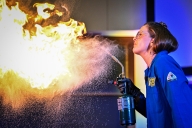You have /5 articles left.
Sign up for a free account or log in.
When Glenn Gunhouse visits the Pantheon, you would think that the professor, who teaches art and architecture history, wouldn’t be able to keep his eyes off the Roman temple’s columns, statues or dome. But there’s something else that always catches his eye: the jaws of the tourists visiting the building, and the way they all inevitably drop.
“Wow.”
There’s only one other way that Gunhouse has been able to replicate that feeling of awe for his students short of booking expensive plane tickets to Italy. Photos, videos and even three-dimensional walk-throughs on a computer screen don’t do it: It’s when his students put on virtual reality headsets loaded with images of the Pantheon.
“That’s an experience … only really made possible with the new headset technology,” he said.
Virtual reality is offering new engagement opportunities for Gunhouse, who teaches at Georgia State University. It’s also caught the attention of some medical and nursing schools, which are using virtual reality or augmented reality to bring three-dimensional anatomy illustrations off of two-dimensional textbook pages.
Although they’re similar, VR and AR differ in a few ways. VR provides a total immersion experience; once you put the headset on, everything you see is part of the world rolled out in the software. With AR, by contrast, you still see everything around you as you normally would, but you can interact with “patients” and dissect “cadavers.”
While early educational outcomes are promising, the costs of VR and AR technologies are still high, and convincing professors, administrators and tuition-paying parents that they are more than just fun video games will take time, advocates say.
Cool, Yes. But Useful?
Despite the relatively limited use of VR and AR in higher education, equipment and software companies are gearing up for growth. For example, Pearson -- best known for its textbook publishing arm -- has been working on VR/AR projects for about three years. Pearson has a partnership with Microsoft to supply AR software for Microsoft’s HoloLens headset. (Pearson officials say that the company and Microsoft are making headway establishing partnerships with institutions ahead of the HoloLens being available for public retail. No release date has been set.)
Mark Christian, Pearson’s global director for immersive learning, said his team rejects ideas for creating new VR/AR content if they don’t lend any value, or if they can be created as efficiently and cost-effectively with two-dimensional software.
“We’re focusing on STEM fairly heavily, and that’s because we think we can make the most difference in those subjects,” he said.
Take chemistry, for example. “We’ve all seen the rods and balls” that make up the physical models of molecules, Christian said. But with VR and AR “you can build anything, and students can share their materials, together.”
Pearson has a partnership with the Royal College of Surgeons in London, in an effort to integrate AR into surgical training, aimed at both young surgeons learning a procedure for the first time and older surgeons trying out a new technique.
The takeaways from the medical field can be applied to other disciplines, Christian said. Using VR and AR, for instance, social work students can “visit” prisons and education students can “interact” with youngsters in a classroom.
“[Students] can do things wrong,” Christian said. But with VR and AR, users receive instant feedback.
Peter Campbell, a former Pearson employee, runs a consulting firm that works with VR and AR technology companies. Mersion, one of those companies, offers a program designed to place student teachers in a classroom with students.
“I knew this was a simulation, but during the interaction, all of those things melt away,” said Campbell, who tested the program. A former teacher himself, he said he had trouble managing an unruly student.
“We were able to pause the simulation and get feedback right away,” he said. “It’s a safe environment, you can afford to fail.”
And by addressing those failures outside of the real classroom -- or the operating room or chemistry lab -- VR and AR advocates hope that students will be better prepared for real work challenges.
Quantitative Questions
The theory is intuitive -- practice in VR or AR simulations will lead to better outcomes in training and post-graduation jobs. But are there data to back that up?
“We don’t even know what we don’t know yet,” said Deb Adair, executive director of Quality Matters, a consortium of institutions and publishers that places quantitative measures on online learning methods and products. Still, she said, VR and AR are on QM’s radar, and the experience of going through the motions in the classroom would be helpful.
Large amounts of hard data regarding VR and AR just don’t exist, because the market is relatively new, said Campbell, who describes himself as skeptical, but optimistic about the technologies.
“I would encourage [people] to be skeptical, but also to engage, and develop their own studies, collaborate together,” he said. His company, xpereal, is working with San Diego State University -- where the nursing school has a partnership with Pearson and Microsoft’s HoloLens -- to collect data around engagement, outcome and efficacy around the use of VR and AR.
“I think we’re going to come up with compelling threshold data, but these will be new data,” he said.
Case Western Reserve University, which has a partnership with Microsoft, too, has been collecting data as it runs pilot AR health care courses and sessions with its HoloLenses. In one survey taken after a 90-minute anatomy class with the HoloLens, professors found that 86 percent of students “learned something new.”
“We had expected that maybe some of the poor (performing) students would answer yes,” Mark Griswold, a professor of radiology at Case Western, said in an email. “But in follow-up questions, [all the students] talked about how they were in particular able to study the diaphragm in ways that they couldn’t do at all with a cadaver.”
“Beyond this, 100 percent of the students in all of the surveys that we've done have indicated that they want to come back... again indicating that they feel this is useful and not just a toy,” he said.
Case Western plans to collect more controlled data through 2018.
Collecting data might be the key to getting skeptics to look at VR and AR beyond “cool,” said Ray Schroeder, associate vice president for online learning at the University of Illinois at Springfield and director council for online education for the University Professional and Continuing Education Association.
“Higher education is moving beyond just the coolness factor to looking at outcomes,” he said. But, he added, “What are the outcomes?”
The Affordability Factor
Accessibility in regards to VR and AR is a multifaceted challenge. The Oculus Rift headset costs $600, while the HTC Vive is $800. Microsoft’s HoloLens hasn’t been released commercially yet, but Pearson officials say it will be $3,000.
And those costs don’t include software for the headsets or the graphics cards required to run programs on some computers.
However, the cost of one cadaver can be $1,000 or more, according to Pearson officials, and it's also single use. (Technically the sale of dead bodies is illegal, though colleges pay transportation, storage and other costs.)
That doesn’t necessarily mean that VR or AR will replace cadavers, but the technologies have the potential to give students more feedback and practice before their first dissection. They also are less expensive over time than paying actors to come to classes to fake illnesses or operating health clinics.
One of Pearson’s current medical-related AR projects involves a patient, “Dave,” who exhibits variety symptoms of a given disease. Pearson has gathered feedback from students at Texas Tech and San Diego State who are testing “Dave,” and made some tweaks, including correcting the color of the phlegm he produces.
On the other hand, software isn’t always compatible across different headsets, meaning purchasing one type of hardware represents a gamble itself.
While the costs are high now, they will inevitably drop, said Schroeder. “The very high end is coming down in price every year,” he said.
A Lower-Cost Option
Another option -- albeit less advanced -- is the Google Cardboard headset, in which users simply mount their smartphones inside and load VR/AR programs. It retails for $15.
Ryan Carney, assistant professor of digital science at the University of South Florida, said the VR models he uses in his “digital dinosaurs” course are compatible with Cardboard, although he also uses AR technology with HoloLens headsets. The technologies allow Carney’s students upload, adjust, map and animate dinosaurs and their skeletal structures.
“Virtual reality and augmented reality really provide a new way of looking at old fossils,” he said. “It’s also uniquely engaging. Instead of static, two-dimensional images, we have dynamic three-dimensional models in an immersive environment that students can interact with.”
Gunhouse, of Georgia State, said he has a personal headset -- an Oculus Rift. He arranges for students to use his headset in a one-on-one setting, and a colleague has a couple headsets learners can use, too. Students can also arrange to use a handful of HTC Vive headsets that are available at the university’s library, and there is a classroom on campus set up with a few Oculus headsets as well.
Gunhouse also makes his programming available for use on a computer, albeit in a less immersive format. But that has limitations -- some students report that their laptops can’t always keep up with the processing power required to run the in-browser programs.
Pearson hopes to package its VR and AR services with its textbooks. Although current costs for VR and AR programs and headsets are high, Christian said sales are slated to start in earnest next year.
“Professors are very interested, and find it compelling,” he said, adding that he was unable to disclose the exact number of sales and partnerships Pearson has lined up.
For all the talk about moving past the “wow” factor, it still has its advantages. Gunhouse even said it’s an important part of the learning process.
“A critic once said that students weren’t learning anything, they were just getting a sense of awe,” he said of using VR to showcase historic architecture and buildings. “The building was designed to give you a sense of awe, so if students get a sense of awe with the headset, they have learned something about the building. That’s not incidental or something to be dismissed.”








